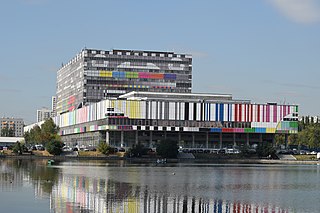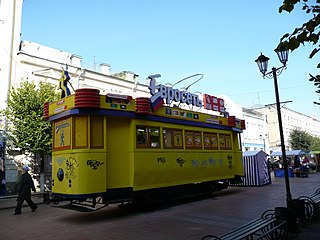Related Research Articles

The telecommunications in Russia has undergone significant changes since the 1980s, radio was a major new technology in the 1920s, when the Communists had recently come to power. Soviet authorities realized that the "ham" operator was highly individualistic and encouraged private initiative – too much so for the totalitarian regime. Criminal penalties were imposed but the working solution was to avoid broadcasting over the air. Instead radio programs were transmitted by copper wire, using a hub and spoke system, to loudspeakers in approved listening stations, such as the "Red" corner of a factory. This resulted in thousands of companies licensed to offer communication services today. Due to the enormous size of the country Russia today, the country leads in the number of TV broadcast stations and repeaters. The foundation for liberalization of broadcasting was laid by the decree signed by the President of the USSR in 1990. Telecommunication is mainly regulated through the Federal Law "On Communications" and the Federal Law "On Mass Media"

Ostankino Tower is a television and radio tower in Moscow, Russia, owned by the Moscow branch of unitary enterprise Russian TV and Radio Broadcasting Network. Standing 540.1 metres (1,772 ft), it was designed by Nikolai Nikitin. As of 2022, it is the tallest free-standing structure in Europe and 12th tallest in the world. Between 1967 and 1974, it was the tallest in the world. The tower was the first free-standing structure to exceed 500 m (1,600 ft) in height. Ostankino was built to mark the 50th anniversary of the October Revolution. It is named after the surrounding Ostankino district of Moscow.
Vremya is the main evening newscast in Russia, airing on Channel One Russia and previously on Programme One of the Central Television of the USSR. The programme has been on the air since 1 January 1968 and has broadcast in color since 1974.
Television in Bulgaria was introduced in 1959. Global players such as News Corporation, Modern Times Group, Central European Media Enterprises, Fox Broadcasting Company and others operate the biggest and most popular media outlets in the country.
Russia-1 is a state-owned Russian television channel, first aired on 14 February 1956 as Programme Two in the Soviet Union. It was relaunched as RTR on 13 May 1991, and is known today as Russia-1. It is the flagship channel of the All-Russia State Television and Radio Company (VGTRK).

VID, stylized as ВИD, lit. "View"; acronym of VzglyadiDrugiye, "Outlook and Others", formerly VIDgital from 2017 to 2020, is a Russian and former Soviet TV production company. VID produces shows for Channel One Russia, NTV and OTR. It is best known for producing the television programmes Wait for Me, designed to help people find loved ones and Pole Chudes which is a popular Russian version of Wheel of Fortune.

2×2 is a Russian television channel. Founded in 1989, it was the first commercial TV station in the Soviet Union. The channel was shut down from 1997 to 2003, at which point it was started up again. Since then, the channel has predominantly broadcast foreign animated TV series, including children's television series, anime, and adult animation shows.

TV Centre is a Russian public television station with the fourth largest coverage area in Russia, after Channel One, Russia-1 and NTV. It is owned by the administration of the city of Moscow and is dedicated to programming that highlights various aspects of Moscow life. The channel airs across Russian territory.

ATV is the oldest Russian private TV company. It was founded in the USSR on September 15, 1988 by Anatoly Malkin and Kira Proshutinskaya. It reached its height in popularity in Russia in the 1990s.
Nickelodeon was a Russian language children's television channel launched on November 15, 1998, across the Post-Soviet states.
Television is the most popular medium in Russia, with 74% of the population watching national television channels routinely and 59% routinely watching regional channels. There are 6,700 television channels in total. Before going digital television, 3 channels have a nationwide outreach : Channel One, Russia-1 and NTV.

Russian Television and Radio Broadcasting Network (RTRN) (Russian: Российская телевизионная и радиовещательная сеть) is a unitary enterprise created on August 13, 2001, by decree of the president of the Russian Federation. The company is included in the list of Russian strategic enterprises.

Cartoon Network is a children's pay television channel in CIS & Southeast Europe which was launched on 1 October 2009, replacing the pan-European feed of Cartoon Network in those regions. Cartoon Network is available in Bulgarian, Croatian, English, Russian, Serbian and Slovene.

The Central Television of the USSR was the state television broadcaster of the Soviet Union.

Tricolor TV is Russia's largest direct-to-home provider based in Saint-Petersburg and has broadcast two hundred TV channels in the European part of Russia and Siberia since 2005. As of October 2014, Tricolor TV provided satellite services to over fifteen million subscribers.

Mobile phone industry in Russia is a trade industry of cell phone devices and mobile network services in Russia. Since the collapse of the Soviet Union in the 1991 it had seen a great expansion over the last decades becoming one of the largest in the world. In terms of number of smartphone users, Russia is the 4th biggest smartphone market in the world sitting behind only China, India, and USA.
Programme One known also as TS.T-1 was a television channel produced and transmitted by Soviet Central Television, the television broadcasting organization of the USSR. It had a mixed schedule of news and entertainment, with the emphasis on events in the USSR, and also included regional programming.
Satellite television varies in the different regions around the world.

Ostankino Television Technical Center is a television studio and technical center in Moscow, Russia for Channel One Russia. The center provides ongoing technical support to multiple broadcasters in the country.
Alexander Mikhailovich Lyubimov is a Soviet and Russian television journalist, producer and presenter. He was one of the founders an independent television company VID (17.14%). Director General of the TV company VID (1995-1997), General Director of RBC TV (2011-2014), vice-president of the Russian Television Academy.
References
- ↑ "Kosmos TV". Archived from the original on 2001-04-05.
- ↑ Bazyler, Michael J.; Sadovoy, Eugene (March 1, 1991). "Television and the Law in the Soviet Union". Loyola Marymount University . Archived from the original on December 3, 2020.
- 1 2 3 4 GOING TO DIGITAL EXTREMES, The Russia Journal, 7 December 2000
- 1 2 3 4 Битвы за "Космос ТВ"
- ↑ Спутниковое телевидение: каждый в своей тарелке – Деньги – Коммерсантъ
- ↑ Kosmos to Launch Digital TV Service, The Moscow Times, 17 November 2000
- ↑ "Система" оставила себе "Космос-ТВ"
- ↑ Интервью Андрея Степанова, генерального директора ЗАО "Космос-ТВ"
- ↑ Космический персонаж
- ↑ "Космос-ТВ" прекращает вещание